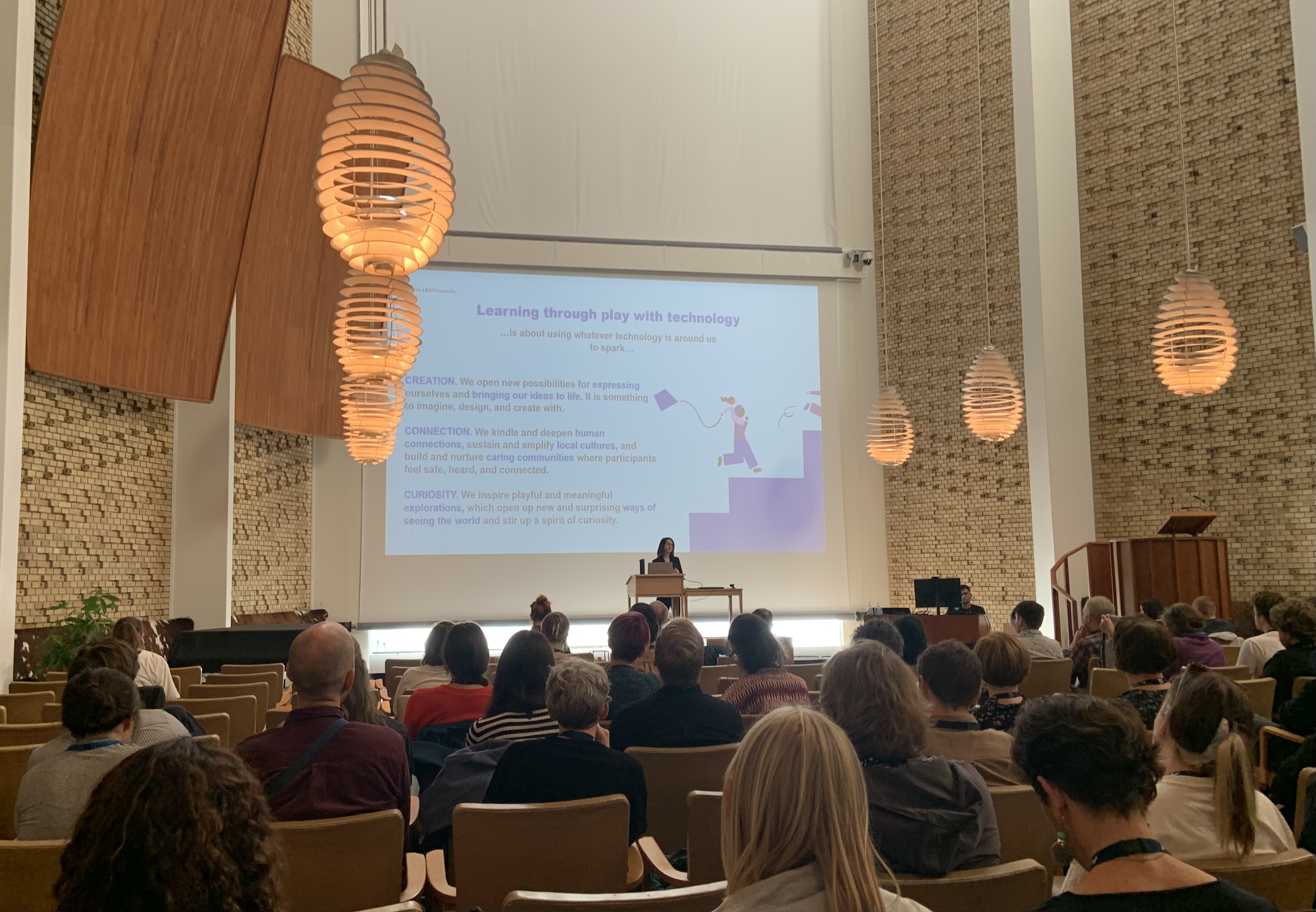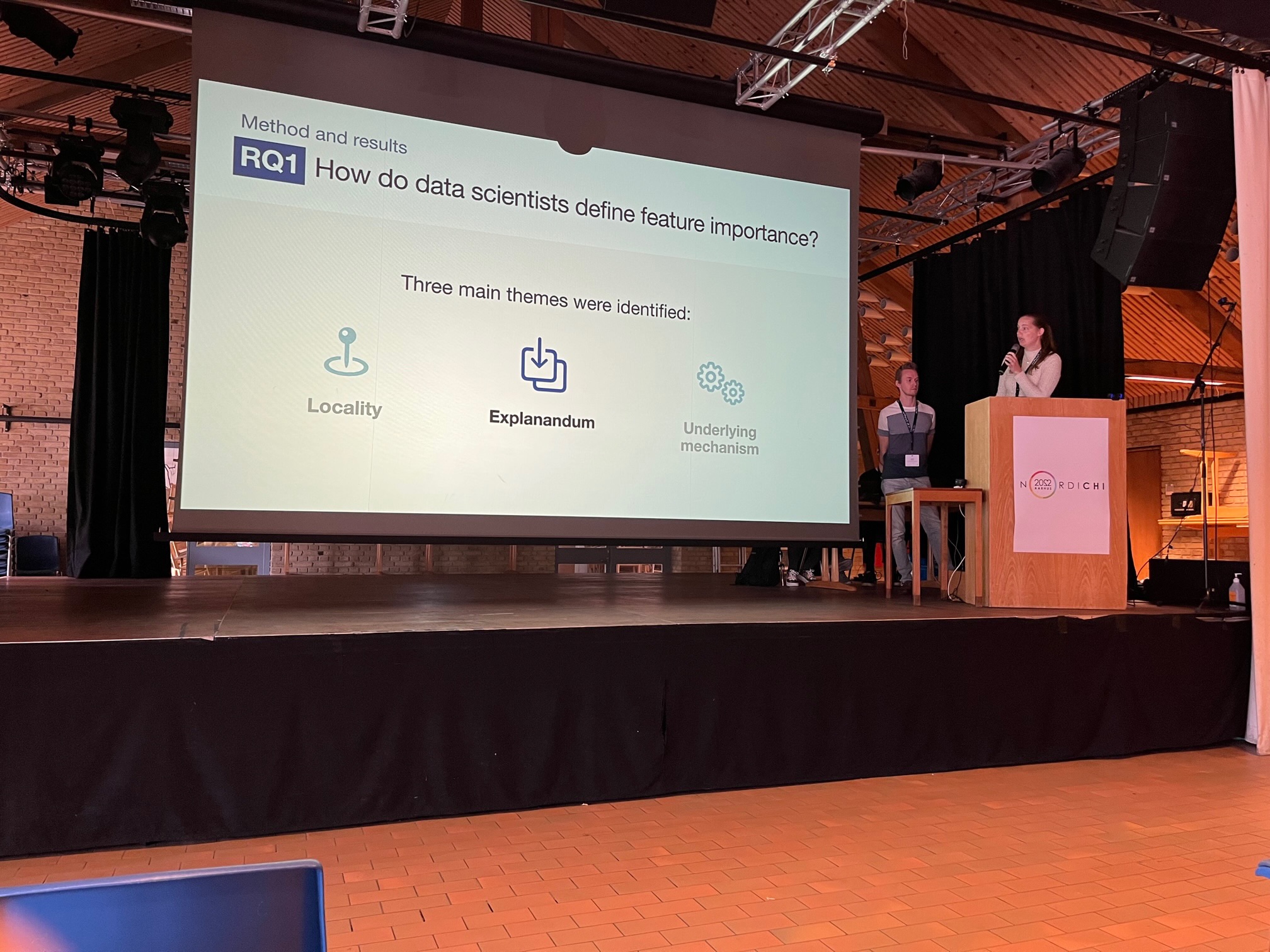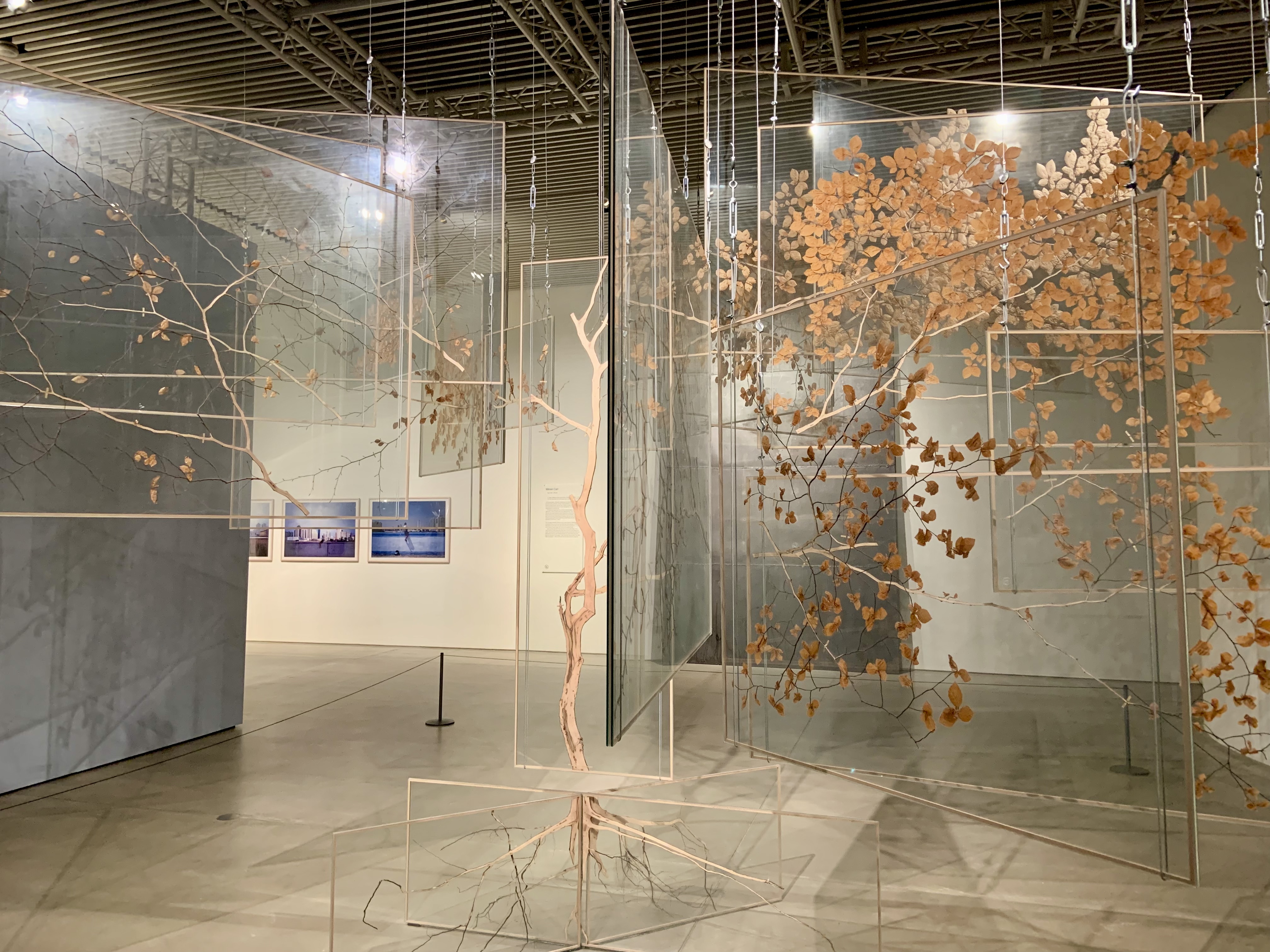Here it was! My first CHI-related conference! Ever since the start of my PhD, I had the goal to explore this community that I'm adjacent too. In 2020 I was supposed to go to CHI in Hawaii, but we all know what happened there... So, NordiCHI in 2022 was my second chance at this, with destination Århus. For our paper accepted at NordiCHI, we had been working in an inter-disciplinary team in the Data Science domain of TU/e. Dennis and Hilde together come up with the initial idea, I was in a supporting role for the user study, and Jack and Mykola were there to assist in a supervisory role.
I started the conference on Saturday with the workshop Curating/Fermenting Data. You can learn more about my experiences on this day here. In this blogpost I will elaborate on some of my personal highlights of the main conference.
Sunday
On Sunday, we did not participate in any workshops. However, there was a social activity planned: the Friday-bar. Sounds a bit confusing, and they knew too, but apparently normally the department bars at Aarhus University are only open on Friday. They had awesomely volunteered to open for NordiCHI attendees on Sunday, which meant that we could have a pre-reception, at the Friday-bar! There were multiple options on tap, plus a fridge full of cans, so lots to choose from. Afterwards, we walked to Aarhus Street Food together, where the organizers had reserved 150 seats for dinner. This was a nice opportunity to network, as typically this location seems way too full to find comfortable seating! During the 30 min walk and the dinner, there were plenty of opportunities to talk to other attendees even before the conference began, so I count this as a succes!
Monday
This day was packed! In the opening, we learnt that there were close to 400 registered attendees, of which almost 300 attended in person. As I had never been to NordiCHI before, this number was a definite surprise to me. Furthermore, there had been over 250 paper submissions, of which 29% were accepted.
 Learning through play is about creation, connection and curiosity.
Learning through play is about creation, connection and curiosity.
The opening keynote was given by Elisabeth McClure, who works at the LEGO Foundation. She talked about her work on children learning through play. They do outreach work all over the world, and given the materials available there, design learning activities. This means that their activities look very different if you compare Rwanda, Kenya, Brazil and Denmark, but the underlying principles are the same. The keynote also contained a hands-on experience for us as attendees: make a face with the items you have with you, and explain what this means to you.
 Some of the faces made by our fellow conference-goers.
Some of the faces made by our fellow conference-goers.
After lunch, Dennis and I would present our own work, so we skipped the first paper session to practice a little more, and it paid off. I was very happy with the final results. Our presentation on mental models of Local Feature Importance techniques had very good attendance, although no questions from the audience. We have materials available if you're interested: paper, slides, and a layman explanation.
In our session, there was another paper on mismatched expectations, but then on interactive data visualization dashboards. I also learnt more about the concept of personas, which is a concept in UX design that allows you to design for more specific user groups in the form of made-up users. Clearly, creating artificial personalities is a time-consuming exercise. What was news to me, is that they would also sometimes be generated from social media posts and accounts. As a result, these Personas may sometimes contain toxic quotes, which may lead to a lack of empathy and a designer to be less willing to design for them (and thus the persona being useless). The study examined whether users wanted a 'hate filter' turned on. Designers in the area of journalism want to retrieve raw data, but the authors identified six cases in which this filter is beneficial for others.
In another study of the same author, they examined how many personas should be generated for optimal gains in design. They found that this was around 40 personas (for the social media dataset they used). Creating more, although time-consuming, can be a valuable addition for heterogeneous populations.
 Presenting some of our results.
Presenting some of our results.
After the afternoon session on Design, in which I learnt more about how design (quality) connects to metaphors, timelines and participation, the last session of the day was a combination of reception and demos. Upon registration at the desk, we had received two drink tickets, and the available burgers were fully vegan. There were some really interesting demos available.
Most of the demos went all-in on virtual reality. This is not really something I'm interested in, as I feel these headsets are way overused in most cases. But, there were lost more interesting concepts to discover. For example, we attended the TU Eindhoven demo that facilitates children's exploring behavior through some sensors and connected displays. Then, we found a demo that recreated an ear in wax and created a visual representation of the sound that the ear 'attended to'. Throughout the room you could hear people make weird sounds or shout in order for something fun to show up on the print-out! Finally, we found Webstrates, an interesting demo that applied the concept of live editing such as in Google Docs, to any browser window. As such, you could use it as a shared whiteboard, code together, or create a design. This project has been 10 years in the making, and I thought it was very promising, especially for educational purposes.
Tuesday
On Tuesday morning, we used the free ARoS ticket that we received at the registration desk. It was a lovely gift, as we had wanted to visit ARoS anyway. We then jumped back in the conference from lunch, which we had in the Antikmuseet on Tuesday. It was really fun to see the replicas of famous Greek and Roman sculptures, trying to recognize which one they were without reading the signs.
 An artwork at ARoS.
An artwork at ARoS.
Session - Learning and Understanding
After lunch, it was time for the session Learning and Understanding, the one I was looking forward to most. The first paper was on Cotinker, a cross-device collaboration tool built with the Webstrates platform I mentioned above. This meant that the students could work together on coding problems, and their work would immediately be synced.
The third paper in the session was about teaching ML concepts to K-9 students. For this purpose, they had created two tangible user interfaces that represented the two main aspects of ML: learning and classification. Then, to move beyond this superficial concepts, they allowed the students to learn more about the insides of the model through QR-codes on different parts of the devices. This would bring them to parts of the code/model, that they could also tinker with.
The last paper of the session was presented by Max, who we had met on Sunday during the social drinks. He gave a presentation about end user perceptions of manipulative patterns online. Manipulative patterns are design elements that try to manipulate the user into doing something that is beneficial for the owner of the page, such as buying and item, providing personal information, or clicking a link. Max explained how these manipulative patterns can be mild, or blatant. They were wondering both how end users evaluated these patterns, and whether experts could accurately predict end users interpretations of these patterns. They found that experts and end users voted similarly on the intrusiveness of the patterns, but the experts overestimated end users' negative perceptions. End users struggle to identify subtle patterns, and rated patterns as more ethical than experts. As such, it would be good if we all read this paper to learn more about which patterns exist, such that we are more likely to recognize them!
The next session was a combined coffee break and poster session. I made a short round through the posters, but found that none of them really gathered my attention. So, while I left Dennis to discuss with the authors of the two papers he really wanted to see, I worked on my blog post on the Saturday workshop Curating/Fermenting Data.
After the poster session it was time for the conference dinner. This was held at Godsbanen, some sort of municipal cultural center, where which anyone with a good idea could apply for a space to undertake their project. We started with a toast and then had some very nice (vegan!) food. Between the main and the dessert, there was an artist giving an improvisation performance, which some people took very seriously, while others could not make anything of it. I guess I fell somewhere in between these two camps... We left after the dinner, before the party really got started, as we really wanted to attend the keynote the following morning.
Wednesday
And then it was already the last day of NordiCHI 2022! It started with coffee, which was highly necessary for some people after the banquet!
Keynote - Kasper Hornbæk
The keynote was given by Kasper Hornbæk, and was called Implications for Theory. He started with one of his take-aways: add a section called implications for theory to your paper's discussion! Why? Because the HCI community, according to Kasper, engages to limitedly with theory, which has negative consequences for the field.
Theory is perhaps a vague concept, and many definitions are available. There are also quite some theories to choose from! And we could use them in so many ways. As a little proof of concept, Kasper had analyzed the accepted papers to NordiCHI this year, and only 5 papers mention 'theor*' in their abstract.
So, what does he argue for? We can apply theory in many ways:
- Theory as background. This is what happens most often. Theories come up in related work, but then are never referred to again.
- Theory for discussion. Related to the aforementioned point, but then in the discussion section. The theory is used as a lens to reflect on findings, but this is oftend disconnected from the rest of the paper.
- Theory as an analysis tool. Using a theory, often a taxonomy, as a way to classify data. So, the theory is used, but not in-depth.
- Theory as a methodological tool.
- Theory for design.
The fact that as a community, we mostly use theory as a shallow source means that we are reinventing the wheel. We are often writing work that cannot be wrong: results that come from explorative, qualitative studies are true by default, as they do not make any strong claims. There are no motor theories, that lead to many new publications. There are very few replications.
 Kasper argues that we should theory more, to reason with it and criticize it.
Kasper argues that we should theory more, to reason with it and criticize it.
So, what should we be doing then? Kasper gave some suggestions:
- Use theory more. We should reason with theory about new situations. We should form our expectations before our analysis, and focus on the why of our findings.
- Test theories. We should not just use theory to position our research. Instead, we should look for 'forks in the tree of research', and explore inconsistencies and incompatibilities between them.
- Build theories. Instead of writing papers that cannot be wrong, we should dare to make stronger claims if we ever want to create new theories. These should tackle key issues that we do not have good theories for yet: usability, experience, interaction, appropriation and so on.
- Embrace theory pluralism. All theories are limited. Instead of positioning using just one theory, we should combine and compare theories to make our work better.
- Create implications for theory. Add this section to your paper's discussion. Always come back to the theories you have used in the main body, and discuss what the implications of your findings are.
This work turned out to be really polarizing for the community, as had been announced by some attendees on Twitter. As a result, the question session afterwards was full of 'This is more a comment than a question, but...' This discussion was sometimes a bit hard to follow, given our positioning outside of the field. Nevertheless, I think the keynote was really valuable, for people outside of HCI as well. In my work, on the CSEd plane, we often have a section 'Implications for teaching', and our Discussion sections are much more in-depth on theory than those in other areas of CS. But even we could do more to test, build and compare theories.
Session - Personal Technologies
The final session I attended was the one on Personal Technologies, which focused on the use of apps for mindfulness, sleep-tracking and journaling. The work on mindfulness was all about persuasive design: design that can support the user to create or maintain a positive habit, or stop a negative habit. This often contains elements of gamification such as streaks and awards. End users often select mindfulness apps as a way to manage stress and increase mental well-being. In games that also include gamification, their goal becomes split in two: they want to become more mindful, but they also want to keep their streak! The streak may be a means to help them be motivated to do the exercises, but does not contribute to mindfulness itself. This may lead end users to feel like they have to perform. We should keep in mind when designing such applications, where the satisfaction comes from.
The paper on designing for extreme sleepers took a look at personal technologies that focus on sleeping. Technology has influenced sleep significantly: we now have reliable light, alarm-clocks, smart watches... However, the design of the latter, and the apps associated with it, often focus on normative sleepers. These people work from approximately 9 to 5, and sleep around 8 hours each night. But of course, this is not a universal sleeping pattern: we have siestas, polyphasic sleepers, people of different chronotypes, shiftworkers, nightworkers, etcetera. In this study, the paper examined the relation between non-normative sleep patterns and other aspects of life by interviewing non-normative sleepers. They found that these people were struggling with the lack of social connection because of differing schedules, and the connection between sleep and other bodily functions such as hunger. Finally, the values of the hours on the clock often differ for these people. For normative sleepers, it is clear what the hours on the clock mean: we work from 9 to 5, eat at 7, 12 and 7 (or something similar), and go to bed at the same time everyday. However, when your schedule is changing often, you have to recalibrate which hour is which. It would be helpful if technology could give these non-normative sleepers better insights into these values.
 Bye bye NordiCHI!
Bye bye NordiCHI!
Closing
And then the conference was over! First, of course there was a round of thanks to all people who had helped make NordiCHI a success, such as the organizers, the session chairs, and the student volunteers. As NordiCHI is biennial, NordiCHI2024 was announced, which will be held in Uppsala, Sweden. Plus, there was the idea to fill the gapyear between the two with a summer school.
Personally, I also had a good time at NordiCHI. The conference was a bit more design-y than I had thought it would, although it was nice to see some other topics for a change. Plus, I am a fan of qualitative work, so at least that box was ticked. However, I do think the conference could become more interesting if a couple (or more) people would follow Kasper's advice and would dare to make stronger statements.
Many thanks to everyone who worked on making NordiCHI a success!